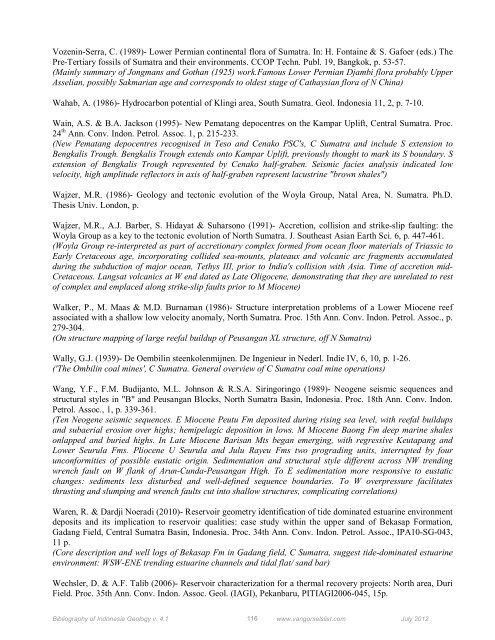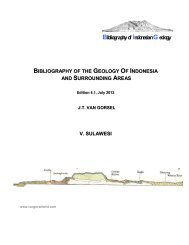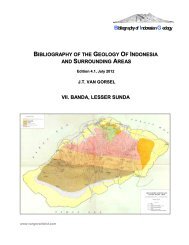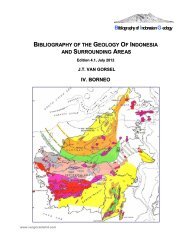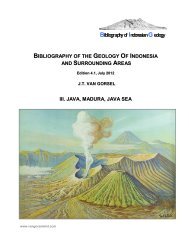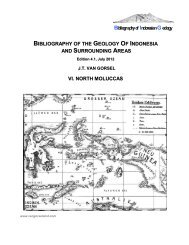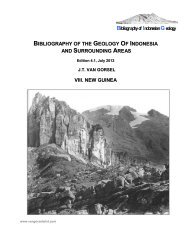Sumatra, Sunda Shelf, Natuna - Bibliography of Indonesia Geology
Sumatra, Sunda Shelf, Natuna - Bibliography of Indonesia Geology
Sumatra, Sunda Shelf, Natuna - Bibliography of Indonesia Geology
You also want an ePaper? Increase the reach of your titles
YUMPU automatically turns print PDFs into web optimized ePapers that Google loves.
Vozenin-Serra, C. (1989)- Lower Permian continental flora <strong>of</strong> <strong>Sumatra</strong>. In: H. Fontaine & S. Gafoer (eds.) The<br />
Pre-Tertiary fossils <strong>of</strong> <strong>Sumatra</strong> and their environments. CCOP Techn. Publ. 19, Bangkok, p. 53-57.<br />
(Mainly summary <strong>of</strong> Jongmans and Gothan (1925) work.Famous Lower Permian Djambi flora probably Upper<br />
Asselian, possibly Sakmarian age and corresponds to oldest stage <strong>of</strong> Cathaysian flora <strong>of</strong> N China)<br />
Wahab, A. (1986)- Hydrocarbon potential <strong>of</strong> Klingi area, South <strong>Sumatra</strong>. Geol. <strong>Indonesia</strong> 11, 2, p. 7-10.<br />
Wain, A.S. & B.A. Jackson (1995)- New Pematang depocentres on the Kampar Uplift, Central <strong>Sumatra</strong>. Proc.<br />
24 th Ann. Conv. Indon. Petrol. Assoc. 1, p. 215-233.<br />
(New Pematang depocentres recognised in Teso and Cenako PSC's, C <strong>Sumatra</strong> and include S extension to<br />
Bengkalis Trough. Bengkalis Trough extends onto Kampar Uplift, previously thought to mark its S boundary. S<br />
extension <strong>of</strong> Bengkalis Trough represented by Cenako half-graben. Seismic facies analysis indicated low<br />
velocity, high amplitude reflectors in axis <strong>of</strong> half-graben represent lacustrine "brown shales")<br />
Wajzer, M.R. (1986)- <strong>Geology</strong> and tectonic evolution <strong>of</strong> the Woyla Group, Natal Area, N. <strong>Sumatra</strong>. Ph.D.<br />
Thesis Univ. London, p.<br />
Wajzer, M.R., A.J. Barber, S. Hidayat & Suharsono (1991)- Accretion, collision and strike-slip faulting: the<br />
Woyla Group as a key to the tectonic evolution <strong>of</strong> North <strong>Sumatra</strong>. J. Southeast Asian Earth Sci. 6, p. 447-461.<br />
(Woyla Group re-interpreted as part <strong>of</strong> accretionary complex formed from ocean floor materials <strong>of</strong> Triassic to<br />
Early Cretaceous age, incorporating collided sea-mounts, plateaux and volcanic arc fragments accumulated<br />
during the subduction <strong>of</strong> major ocean, Tethys III, prior to India's collision with Asia. Time <strong>of</strong> accretion mid-<br />
Cretaceous. Langsat volcanics at W end dated as Late Oligocene, demonstrating that they are unrelated to rest<br />
<strong>of</strong> complex and emplaced along strike-slip faults prior to M Miocene)<br />
Walker, P., M. Maas & M.D. Burnaman (1986)- Structure interpretation problems <strong>of</strong> a Lower Miocene reef<br />
associated with a shallow low velocity anomaly, North <strong>Sumatra</strong>. Proc. 15th Ann. Conv. Indon. Petrol. Assoc., p.<br />
279-304.<br />
(On structure mapping <strong>of</strong> large reefal buildup <strong>of</strong> Peusangan XL structure, <strong>of</strong>f N <strong>Sumatra</strong>)<br />
Wally, G.J. (1939)- De Oembilin steenkolenmijnen. De Ingenieur in Nederl. Indie IV, 6, 10, p. 1-26.<br />
('The Ombilin coal mines', C <strong>Sumatra</strong>. General overview <strong>of</strong> C <strong>Sumatra</strong> coal mine operations)<br />
Wang, Y.F., F.M. Budijanto, M.L. Johnson & R.S.A. Siringoringo (1989)- Neogene seismic sequences and<br />
structural styles in "B" and Peusangan Blocks, North <strong>Sumatra</strong> Basin, <strong>Indonesia</strong>. Proc. 18th Ann. Conv. Indon.<br />
Petrol. Assoc., 1, p. 339-361.<br />
(Ten Neogene seismic sequences. E Miocene Peutu Fm deposited during rising sea level, with reefal buildups<br />
and subaerial erosion over highs; hemipelagic deposition in lows. M Miocene Baong Fm deep marine shales<br />
onlapped and buried highs. In Late Miocene Barisan Mts began emerging, with regressive Keutapang and<br />
Lower Seurula Fms. Pliocene U Seurula and Julu Rayeu Fms two prograding units, interrupted by four<br />
unconformities <strong>of</strong> possible eustatic origin. Sedimentation and structural style different across NW trending<br />
wrench fault on W flank <strong>of</strong> Arun-Cunda-Peusangan High. To E sedimentation more responsive to eustatic<br />
changes: sediments less disturbed and well-defined sequence boundaries. To W overpressure facilitates<br />
thrusting and slumping and wrench faults cut into shallow structures, complicating correlations)<br />
Waren, R. & Dardji Noeradi (2010)- Reservoir geometry identification <strong>of</strong> tide dominated estuarine environment<br />
deposits and its implication to reservoir qualities: case study within the upper sand <strong>of</strong> Bekasap Formation,<br />
Gadang Field, Central <strong>Sumatra</strong> Basin, <strong>Indonesia</strong>. Proc. 34th Ann. Conv. Indon. Petrol. Assoc., IPA10-SG-043,<br />
11 p.<br />
(Core description and well logs <strong>of</strong> Bekasap Fm in Gadang field, C <strong>Sumatra</strong>, suggest tide-dominated estuarine<br />
environment: WSW-ENE trending estuarine channels and tidal flat/ sand bar)<br />
Wechsler, D. & A.F. Talib (2006)- Reservoir characterization for a thermal recovery projects: North area, Duri<br />
Field. Proc. 35th Ann. Conv. Indon. Assoc. Geol. (IAGI), Pekanbaru, PITIAGI2006-045, 15p.<br />
<strong>Bibliography</strong> <strong>of</strong> <strong>Indonesia</strong> <strong>Geology</strong> v. 4.1 116 www.vangorselslist.com July 2012


